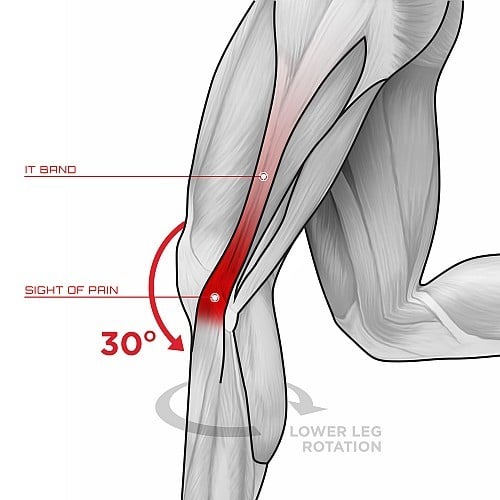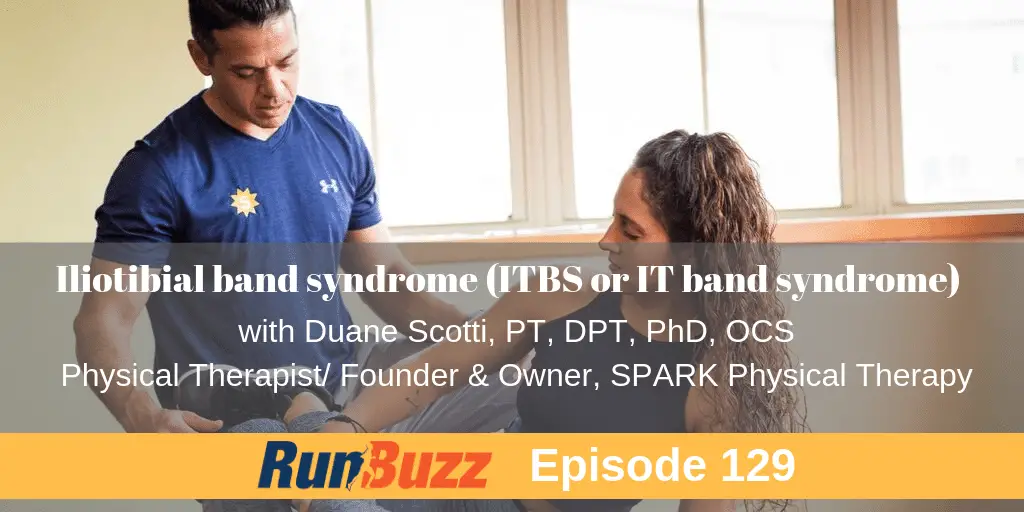In this episode of the RunBuzz podcast, I speak with Duane Scotti, a physical therapist and owner of Spark Physical Therapy. We dig into the topic of Iliotibial Band Syndrome (ITBS) more commonly known as IT Band Syndrome. Duane is an expert on the topic having done his PhD dissertation on the topic.
IT Band Syndrome is one of the most common running injuries and can be quite painful. It is an overuse injury and getting over IT Band Syndrome can be quite a nuisance. However, Duane shares what you can do to beat it. Specifically, we discuss:What is IT Band Syndrome and how do I know if I have it?What causes IT Band Syndrome?How do we treat it?How do we prevent it?
What Is IT Band Syndrome And How Do I Know I Have It?

Iliotibial Band Syndrome is one of the most common overuse injuries we see among runners. It occurs when the Iliotibial Band is tight, aggravated or inflamed as it runs over the bone on the outside of your knee. The IT Band is a thick band of connective tissue that runs from the outside of your hip to the outside and across the knee. When this tissue becomes inflamed, it can cause pain at or near the knee, or along the tissue up to the hip (rare) and can stop a runner in their tracks. While IT Band syndrome can be problematic, there are ways to make it go away.
What Causes IT Band Syndrome?
Lot’s of factors can cause IT Band Syndrome, but the first area we look at when it comes to cause, is load. What is the load, or stress we are placing on our body when we run. Since IT Band syndrome is a repetitive, overuse injury, we can quickly determine that IT Band pain is caused by inflammation and irritation due to doing too much, too quickly before our body is used to it. However other factors play into it. Not every runner gets IT Band pain because every runner is different. We all have our strength’s and weaknesses.
Other risk factors that may play a part in the onset of IT Band Syndrome include:
- IT Band length – Some runners have a shorter, tighter IT Band and therefore this fibrous, connective tissue pulls on it’s attachment points or rubs against the knee often causing pain in some runners and not at all in other runners with a longer IT Band length.
- Weakness in the side abductor muscles – This is one of the biggest risk factors for ITBS. Weakness in the hip abductors, gluteus medius, as well as your hip rotators. When these muscles are weak, they can throw off our running mechanics. For example, when there are weaknesses in these areas, our knees tend to dip in more causing additional stress as the tibia rolls in more as well as hip drop when looking at runners from behind.
- Road or trail surface – Roads that aren’t level often cause one leg to develop more than the other since one leg is longer that the other often leading to hip drop. Over time, this puts more stress on the IT Band.
How Do I Get Rid Of IT Band Pain?
Getting rid of IT Band pain may be something we can do without medical intervention, but if pain is severe and chronic, or not responding to initial treatment, then please see a physical therapist. Getting rid of IT Band syndrome requires you to get rid of the root cause of what is causing it. If you don’t, IT Band pain will get worse or not resolve. Root cause identification is not always obvious and can often require a qualified health professional who works with runners on a regular basis to look more into your specific situation. The first thing you should do is back off your training a little bit. Unless you have a high degree of inflammation, you can, and probably should continue running in order to prevent loss of cardiovascular fitness and muscle loss due to inactivity. Since IT Band Syndrome is often caused by muscular weakness, it is important to continue strengthening the area through running and rehab exercises. If it is in fact due to a result of inflammation, a short term, initial bout of NSAIDs and ice can also help get your inflammation under control.
DO NOT foam roll the IT Band at the outside of the knee. This can cause further irritation and prevent the inflammation from settling. Instead, try foam rolling on the upper part of the IT Band near the hip, as well as more towards the top of your quad muscle, or behind hitting those edges of the IT Band. This tends to have a more productive outcome than rolling directly on the IT Band itself.
How Can We Prevent IT Band Syndrome?
Instead of running as part of training, think about how you can train in order to run. To be a great runner or an injury free runner, you need to build your foundational strength. The importance of strength training is the #1 reason, I now require my coaching clients to cross train as part of their coaching engagements with me. And while we often turn to strength training or specific exercises to help alleviate IT Band issues, our overall training program plays an important part in prevention. So much so, I now teach runners how to build their own training plans that are highly customized. Programs that are personalized to each individual will always out perform free, generic training plans found in books or online.
In terms of running gait, you can often spot hip drop and weaknesses when you look at your running under video analysis. As you run, you are putting your weight on one foot at a time. If you watch your running from behind on video, your hip should stay parallel to the ground. It should remain level. If it does not, this imbalance can put unneeded pressure on your hip muscles or knees depending on where the pressure is applied and the severity of the weakness. This is why many knee injuries originate from the hips.
Motor control issues can occur from time to time, especially with newer runners. Since good form takes time to learn or naturally fall into, IT Band issues can occur when runners aren’t aware of their running posture and form as they run. Often as we gain experience, our form tends to improve. Not always, but that is the tendency.
Strengthening your gluteus medius muscle, your side hip muscle is one of the biggest things you can do to prevent or overcome the pain and inflammation that comes with IT Band syndrome. Also, adding in single leg exercises is important to maintain or improve that single leg strength.
Help! My IT Band Pain Is Not Going Away!
Look, I get it. No one wants to go to the doctor or physical therapist if we don’t have to. But here is the reality. If you aren’t getting better through self treatment, please go see a physical therapist to get a full evaluation. No one else is as qualified as a physical therapist who works with runners. Physical therapists specialize with human movement. They are usually more qualified than doctors because they specialize in human movement.
You can take all the time off you want and rest, but the reality is the injury will return because you aren’t taking care of the root cause. Wouldn’t you rather deal with it and be over it, than sitting on the couch wishing it would go away? Seek professional help!
A trained professional health care provide, like a physical therapist will help analyze your movement, your gait, your strength, and can also apply advanced tactics to help whether that is dry needling, trigger point therapy. or other types of intervention. You have to decide, would you rather take several months off only to deal with a reoccurrence of the injury later, or deal with it sooner?
For more information on injury prevention or to follow Duane, please check out the following resources:
Spark Your Training Physical Therapy – Duane provides lots of free resources as well as professional guidance on his website and blog. I highly recommend it!Instagram: Follow Duane on Instagram – Duane has an amazing Instagram account where he shares tips and injury preventiom topics. A must-follow if you are on Instagram.Healthy Runner CT Facebook group – A great Facebook group on injury prevention and all things running. I am a member of this group and love the live FB videos and group interaction among the runners that follow him.YouTube Channel – Definitely follow Duane on YouTube. He has some amazing videos and his channel is one of my go-to channels on injury prevention for runners. At the time of this podcast, he has over 67 videos to help runners.
Additional References On IT Band Syndrome
Iliotibial Band Syndrome Treatment and Prevention: 5 Things You Need To Know! – This is an excellent article written by Duane describing much of what we discuss on the podcast. I highly recommend that you read it if you suffer from ITBS!
Iliotibial Band Syndrome [FAST!] Relief of Knee Pain From Running – The following video is an excellent overview of IT Band Syndrome and discusses specific strategies that you can use to get rid of it!
How To Roll The IT Band
The following video provides tips for rolling the IT Band:
- About the Author
- Latest Posts

Steve Carmichael is a running coach, sports performance coach, nutrition coach and has been a recreational runner for over 18 years. Steve holds multiple certifications as a certified running coach through the RRCA and USA Track and Field as well as he is a NASM certified personal trainer, and PN1-L1 certified nutrition coach.
Steve has been coaching since 2010 and has helped thousands of runners online and in the Central Ohio area maximize performance and run injury-free.
Steve is the founder of RunBuzz and Run For Performance.com. If you are interested in working with Steve though his online running and strength coaching services, feel free to reach out.

